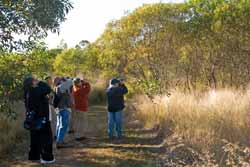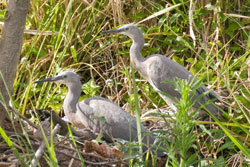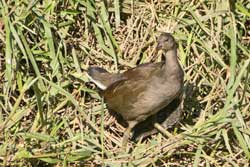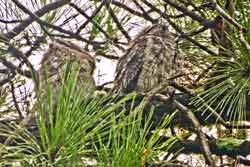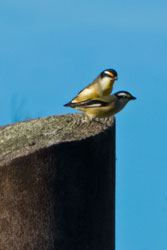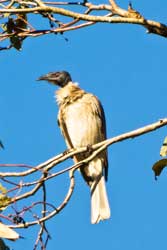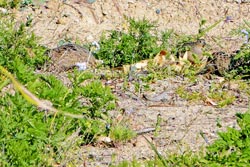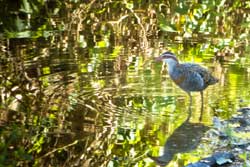To useful links
Details of observations
Detailed results
Summary of 2012 observations
Contact
Background
Since 2008, at least ten bird walks have been conducted each year in locations selected as being representative of bird habitats along Kedron Brook. This project aims to accumulate data on bird life along the Brook; specifically those variations in birds species noted together with their distribution.
Program details for 2012 are available from a small file (PDF, 77 KB). Interested persons should check the latest home page news section to keep up to date on any changes.
To useful links and results from other years
Details of observations to date
Kalinga Park, Keith Boden Wetlands and Benelong Park - 5 February 2012
We were lucky that the weather had cleared for us on Sunday 5 February, because there had been very heavy rain and considerable flooding along the brook in the previous week. The ground was still very wet underfoot, and the damage caused by the extreme volumes of water were very apparent. There had been some quite severe scouring along both banks of the brook at Kalinga Park with some trees uprooted and others in a quite precarious position.
As a result of the wet weather, small birds such as wrens, Silvereyes and pardalotes were noticeably absent. On the other hand, there were quite large numbers of Masked Lapwing and Common Mynahs. Seven Little Pied Cormorants were seen at the Keith Boden Wetlands at Cressy St., Wavell Heights, including one observed sitting on a nest. Corellas were only observed flying over and no Rails were seen, there being very little ‘bank’ left for them to walk on. It was good to see a couple of baby Purple Swamp Hens at the wetlands and pleasing that the resident pair of Bush Stone Curlews were still on the hill at Kalinga Park.
Grange Forest Park - 4 March 2012
We drove to Grange Forest Park on an overcast gloomy morning, ready to cancel the activity. However, the cloud lifted (although it didn't go away) and a few hardy souls decided to proceed with the survey.
Despite the difficult conditions, thirty-nine species were observed and of special note was the sighting of several 'little' birds, desparately seeking sustenance in the wet vegetation. We saw Double-barred Finches, Silvereyes, Red-backed and Variegated Fairy Wrens, White-browed Scrub Wrens and Tawny Grassbirds. It was interesting to see a very young Olive-backed Oriole and a female Rufous Fantail.Just as we were returning to the cars, the clouds lowered and the threatening rain reappeared. However, we were finished, so it didn't matter anymore!
Bellbird Grove, Brisbane Forest Park - 1 April 2012
It was a fine morning and the creek was flowing strongly. Although there wasn't much flowering present in the bushland, forty-four birds species were observed, including Whistling Kites and Brahminy Kites. The very distinctive call of a Brush Cookoo was heard in the main forest area. This bird migrates from SE Australia to northern parts, tends to sit silent and motionless for long periods and is difficult to sight unless it moves. This was the first time this species has been clearly identified in our series of bird walks along Kedron Brook Catchment.
Cassimaty Picnic Grounds, Ferny Grove - 20 May 2012
A small group met at Cassimarty Park in cool but fine weather conditions. We were quite surprised to see a Buff-banded Rail in Beverley Place as we hadn’t seen this bird in that area before. Other Buff-banded Rails were seen later near the bike track in Arbor Park; seemingly unconcerned about the young lads digging and expanding their mountain bike course.
Three White-faced Herons were seen; one sitting on a lamp post next to Samford Road and two in a tree above Beverley Place. It was pleasing to see that the Striated Pardalotes have not been disturbed by all the railway development activity in the area. We saw one still nesting within a lifting hole of a Cedar Creek overflow culvert under Samford Road. A total of eight Laughing Kookaburras seen throughout Cassimarty Park indicates good living conditions are present for this species.
Nundah Cemetery, Bob Bishop Park, Schultz Canal, Nundah Lake - 17 June 2012
It was a cool crisp winters morning with blue sky and sunshine.At Nundah Cemetery lots of little birds were seen, particularly Stirated Pardalotes. At the cattle yards nearby there were several Australian White Ibis, lots of Rock Doves, Common Mynahs and some Common Starlings; all after the discarded bread which was strewn around the yard. Interestingly, we observed half a dozen House Sparrows hanging around a hen house on the property.
Over the three hours walk, five species were observed for the first time since we started surveys in 2008. A Yellow-rumped Thornbill was seen in the trees to the left of the Nundah Cemetery. On a gravel island in the brook, a Black-fronted Dotterel was observed and another was seen at the Nundah Lake. Also at the lake, three Glossy Ibis were sighted, as well as some Royal Spoonbills and a Black Swan.
Nundah Waterhole Reserve and Nundah Beach- 1 July 2012
A small group gathered at the Nudgee Waterhole on a rather cool though sunny morning. The waterhole had been cleaned out, and signs placed on the viewing platform alerting the public to the dangers faced by birds and other wildlife if they are given bread and other 'human' foods. This seems to be working, because although a number of ducks and other water birds were present, they did not approach the platform looking for food.
Red-backed Fairy Wrens were found in their usual habitat of long grass towards the north-western side of the waterhole. Sulphur-crested Cockatoos actively searched for nesting hollows around near the Bora ring site and were also selecting a large tree hollow alongside the very noisy Nudgee Road.
Two Eastern Osprey were sighted with the aid of binoculars on a high branch opposite the boat launching facility near the outfall of Kedron Brook into Moreton Bay. A single Azure Kingfisher and a Mangrove Gerygone were hard to find in the shadows of the mangroves at the outfall.
Brown Quails forage at Wahminda Grove
(2 September 2012)
Grinstead Park and Sparkes Hill Reserve - 5 August 2012
It was a very crisp cold morning as we gathered in the car park at Grinstead Park. The sky was clear and the day held much promise though, so we set off and were almost immediately startled by a host of birds rising skywards and creating a fuss. Soon a Collared Sparrowhawk came into view. No wonder the birds were worried. Lots of Scarlet Honeyeaters made a very colourful sight up in the flowering gums .
A very good sighting of a Shining Bronze Cuckoo occurred on Sparkes Hill and also later, a pair of Fan-Tailed Cuckoos played tag with us along the track. A total of 46 species for the outing made this a very successful morning. The sun gradually warmed the day so coats were removed by the time we were finishing near 10.30 am.
Wahminda Grove - 2 September 2012
We set forth in sunny, though rather crisp, conditions on Fathers Day morning. Of special mention was the family of six Brown Quail, feeding across the track in front of us. We watched for quite a while as they worked from one side of the track to the other, their colour blending into the vegetation; making it quite difficult for the photographer at times. In the same area was a good-sized flock of Red-browed Finches; possibly up to twenty in the group which was feeding in the grasses and on the track as well, sometimes quite close to the foraging quail. Double-barred finches were seen in good number too which was lovely.
There was a bit of excitement when a pair of Yellow-tailed Black Cockatoo’s flew over head about tree-top level; an excellent sighting for us all. A total of thirty-seven species were seen and/or heard for this survey.
Pony Club Bend -14 October 2012
Five members embarked on this walk on Sunday morning in clear sunny conditions. Thirty eight species were observed including three sets of babies adding to our pleasure. The first single baby was a Buff-banded Rail chick, seen running after its mother – very cute. Downstream of the Pony Club Bend walking bridge, a family of Dusky Moorhens had five wooly-looking chicks with them, foraging along the edges of the brook. Two baby Variegated Fairy-wrens posed on a branch in the sun for a photo before flying off to join their parents. There was a good sighting of two Sacred Kingfishers swooping over the Brook trying to avoid the harassment of some Noisy Miners.
On the previous Sunday, 7 October, one member, Esther Townsend, carried out the same area survey on her own. She also observed thirty eight species – which included a Little Corella, a Spangled Drongo, a Fairy Martin, a Brown Honeyeater and a Lewins Honeyeater which the second group didn’t see on 14 October.
Cedar Creek, Upper Kedron - 4 November 2012
Despite wanting to see some rain across our area, we found it was still daunting to see the grey skies greeting us on the morning of our Cedar Ck bird survey. No one would begrudge the rain, but the birding would be very poor in inclement weather. However, the clouds, though grey, stayed high and a successful survey was enjoyed.
It was good to see another Buff-banded Rail in this area of the catchment. These birds have been particularly plentiful this year all along the brook and the one on this occasion gave a good display of itself, crossing open ground so everyone got a good view of it. Blue-faced Honeyeaters were plentiful and of particular interest was a parent bird feeding its young in the branches of a very colourful Jacaranda tree. A good sized flock of Red-browed Finches were seen, as were Red-backed Fairy-wrens and Superb Fairy-wrens.
Despite this extensive housing development occurring in Upper Kedron, it was pleasing to see so many birds at home along the 'green corridor' between the two housing estates. This area will become more and more important to the birdlife as human habitation increases around it.
Detailed results
Results may be linked from this table as the outcomes of the completed studies.
| Date | LInk to | Description |
|---|---|---|
| 05/02/2012 | 8 KB pdf file | Kalinga Park to Cressy St. Wetlands, Benelong Park, Mercer Park |
| 04/03/2012 | 45 KB pdf file | Grange Forest Park |
| 01/04/2012 | 15 KB pdf file | Bellbird Grove/Brisbane Forest Park |
| 20/05/2012 | 17 KB pdf file | Cassimarty Park, Thomsett Park, Arbor Park |
| 17/06/2012 | 15 KB pdf file | Albert Bishop Park, Nundah Lake |
| 01/07/2012 | 15 KB pdf file | Nudgee Waterhole Reserve, Kedron Brook Floodway to Nudgee Beach |
| 05/08/2012 | 15 KB pdf file | Grinstead Park and Sparkes Hill |
| 02/09/2012 | 15 KB pdf file | Wahminda Park & Maureen Lawrence Park, Samford Rd |
| 07/10/2012 | 15 KB pdf file | Pony Club Bend, Osborne Road, Teralba Park |
| 04/11/2012 | 15 KB pdf file | Cedar Creek, Upper Kedron |
This marks the end of five years of surveys along Kedron Brook catchment. A similar program has been set up for the year 2013, based upon a randomisation of the actual sequence of the locations to be visited over the year. This step is to minimise any seasonal effects on the number and type of birds species to be found at a particular location. The apparent absence of a particular species of bird at such a location for one or so years may possibly be explained by a migration influence.
Summary of 2012 observations
Details of all the studies for 2008 through to 2012 are given in the table, 'Table 1 KBCB_WPSQ Results of Bird Studies 2008 - 2012, Summary of study dates, location codes, actual locations and conditions'. This is a small pdf file. Each study location code consists of an acronym of the location name together with a four numeral bit that represents the month and year. Thus, the code, 'FG-AP-BCP-0512', represents Ferny Grove, Arbor and Bob Cassimaty Parks specifically as conducted in May 2012.
A statistical analysis of all of the 2012 bird observations was carried out in a similar manner to that conducted for the previous years using Microsoft Excel worksheets and suitable pivot table analysis to obtain summary information about the surveys.
The bottom section of Table 1 contains the 2012 location codes with details of their location, the date of survey, conditions and leader. The location code is needed to assist the interpretation of the next table entitled, 'Table 2A - KBCB-WPSQ - Common name of bird species found at given coded locations for bird observations at the ten surveys conducted for 2011- (Alphabetic order)'. In column one, the common name of the specified bird as specified by Christidis & Boyles (C&B) is given in alphabetic order down the table. A numeral '1' in the column below any given location code indicates that at least one bird of the species named for that row was observed (or heard with the specific characteristic call) for that location.
As an example of the use of this 'Table 2A', the third column with the 'FG-AP-BCP-0512' location code represents the survey conducted at Ferny Grove, Arbor Park, and Bob Cassimarty Park in May 2012. The top two rows down for that particular column indicate that there weren't any Australasian Grebes or Australian Brush-turkeys observed but the next row down indicates that the Australian Figbird was observed for that survey, and so on.
The companion table, 'Table 2C - KBCB-WPSQ -Common name of bird species found at given coded locations for bird observations at the ten surveys conducted in 2012 (Christidis & Boyles order)' gives virtually the same information. However, the rows are sorted in a different sequence based upon that given down the 'Qld' column of the 'Australian bird list by state' spreadsheet, as obtained from the Birds Queensland web site. The latter information in turn is based upon the original authorative reference by Christidis & Boyles (C&B). Serious birders generally use this ordering method based upon the C&B listing sequence since the resultant order of birds in column one is then based upon a scientifically accepted sequence of names of genus and species for birds. (Note that 'Seq' number used for these KBCB bird listings has nothing to do with the 'Atlas number' used in some other bird lists that, for example, might be used by possibly a member of Birds Australia, or other birding organisations.)
Contact
Bird lovers are always welcome on our walks. Factors such as weather and availability of leadership mean that some outings may need to be changed at relatively short notice. Please contact Outing Coordinator, Jenny Ivin, on phone 3851 0160 or for further information.
CI 13/12/2015

